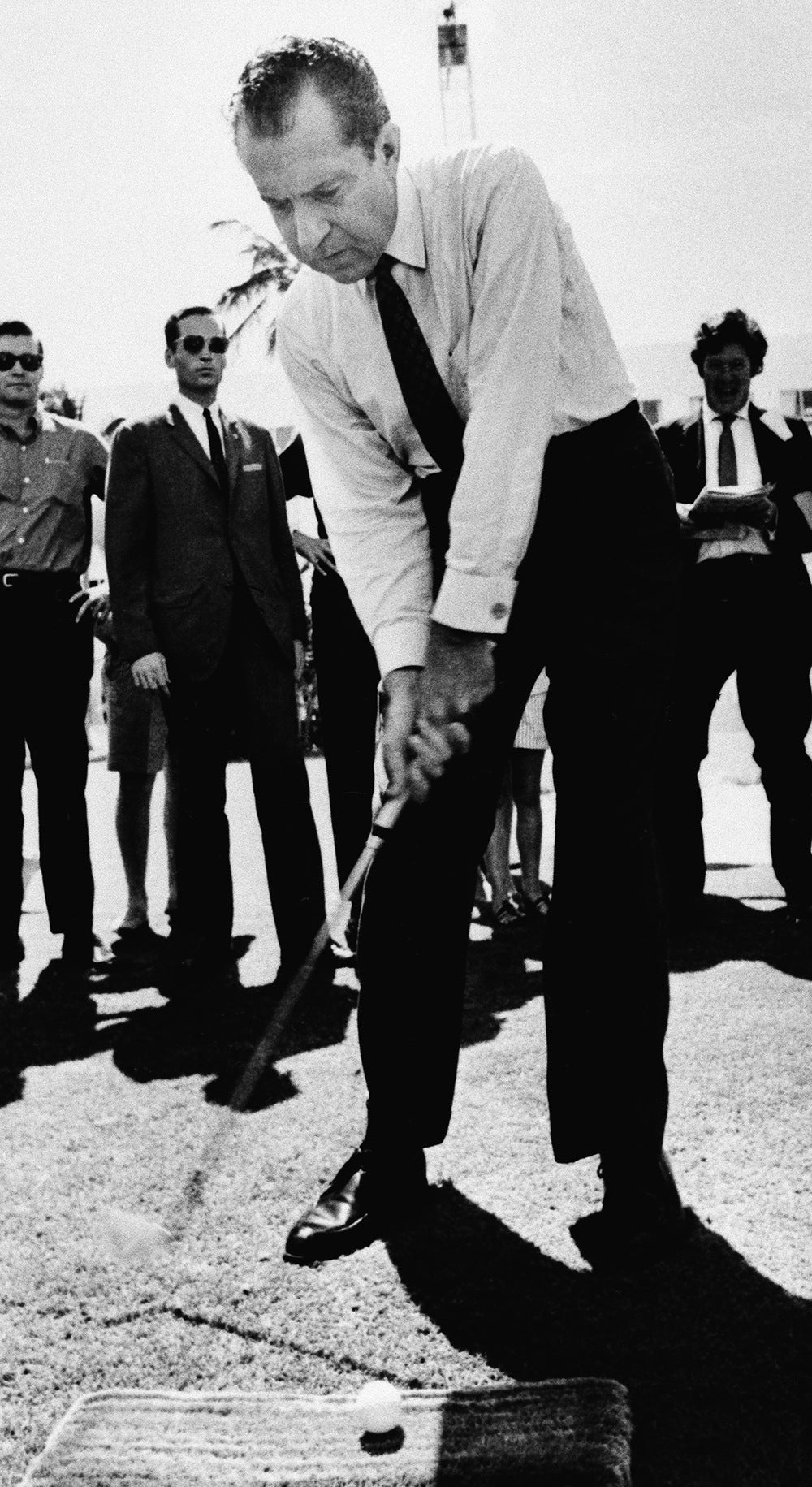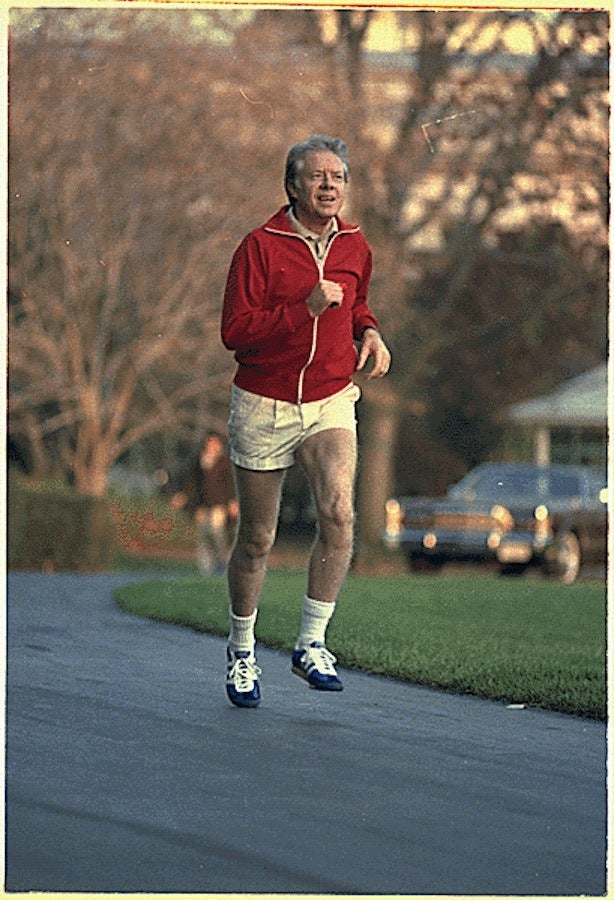Donald Trump is almost always seen interacting with others, online and off. He seems to love the limelight, and his Twitter activity alone suggests he’s prone to spontaneity. So it comes as no surprise that the consensus among psychologists is that Trump is extroverted. The psychologist Dan P. McAdams, writing in the Atlantic, says Trump exhibits “sky-high extroversion.” Trump’s use of his downtime also seems to reflect this tendency.
It’s been noted that Trump has been playing a lot of golf since he became president. But unlike introverted presidents, such as Richard Nixon and Jimmy Carter, Trump hasn’t kept it to his family. He recently invited Japanese prime minister Shinzo Abe onto the golf course, for instance, and has been spotted playing with many businessmen.
On the other hand, Trump recently told a crowd in New Hampshire that he has “no friends.” This coincides with rumors that he is happy watching TV alone in the White House.
If Trump is, in fact, an introvert, he’s one of many that appears to have fooled onlookers into thinking he’s extroverted. He has managed to dedicate much of his spare time to building relations with other people. He is, after all, first and foremost a businessman.
* * *
We’re all guilty of taking it for granted now and then, but the concept of having time to oneself to socialize and indulge in hobbies hasn’t always been a given. It wasn’t until after the turn of the twentieth century, when workers were granted a half-day holiday on Saturdays, that leisure time started to become a part of everyday life. Since then, social scientists have found that what we do with our spare time isn’t just important for our well-being, but also that how we spend it can be quite revealing.
Americans have been incrementally gaining leisure time since records of it began in the 1950s, when the average person worked 1,963 hours a year. In 2015, this dropped to 1,786, according to OECD data.
The sociologist Weaver Pangburn, writing in the American Journal of Sociology in 1922, noted how the workday was starting to become shorter, lending more time for recreation. Pangburn argued that this newfound free time offered “emancipation,” and suggested that downtime could lead to “the disciplining of one’s intelligence, the cultivation of innate artistic ability, the wise indulgence of the creative and social instincts, and the fulfilment of one’s obligations to the community and state.”
Free time, Pangburn writes, offers the opportunity for “reflection, comparison, straight thinking, and experiment,” and is a time for “sorting and arranging” our values, when we can “attain to individuality.”
Everyone needs time to introspect and indulge in hobbies now and again, including American presidents, whose pastimes have long been a source of fascination to the public. Dwight Eisenhower, for instance, played golf “almost every afternoon,” according to the political scientist Merlin Gustafson. Gustafson suggests that, over time, Eisenhower “discovered that the game of golf continued to challenge his athletic skill as well as his self-image and his ego.”
“Perhaps just as important, the game was relaxing for him,” Gustafson states. “It brought escape from the anxieties of his army command and later from his White House duties.… Along with the psychological release, he enjoyed the camaraderie of his golfing companions.” Perhaps, then, Trump’s frequent golfing isn’t all bad.
* * *
According to Barbara Kellerman, lecturer in public leadership at the Harvard Kennedy School, how presidents choose to spend their leisure time offers vital insights into their personalities and leadership styles. In her article for Presidential Studies Quarterly titled “Introversion in the Oval Office,” Kellerman looks at two presidents to see how their hobbies shed light on the way they governed. She focuses on Richard Nixon and Jimmy Carter, who were both introverts. This means they tended to get their energy from being alone or in smaller groups of people, and probably disliked being in highly stimulating environments.
Kellerman writes that both Nixon and Carter “derived no pleasure from ordinary interpersonal activity,” and had “minimal” ability when it came to ingratiating themselves with, and appealing to, new people.
Jimmy Carter spent his formative years in a household where books were so revered they were read at the dining table. Kellerman: “Carter was an unusually bookish lad….Not only did his mother exempt him from household chores if only he called to her that he was reading, it was also her idea that members of the Earl Carter household should be devouring books along with food at mealtime.”
Outside the world of books, Carter’s strongest relationships were with his own family. Carter had difficulty making friends, and didn’t hold very many political gatherings. He didn’t have a good relationship with other politicians, including members of Congress, and his appointees “remained assistants rather than associates, junior business partners rather than genuine intimates who would risk taking a critical stance.”
Or in Kellerman’s words: “During his four years as president, [Carter] made virtually no friends within the government. And outside it, among the body politic, the emotional ties remained as they always had been: weak. The distance that Carter put between himself and most others was apparently felt by the electorate, and there were few tears around the land when he was so soundly and ignominiously dumped.” In other words, Carter’s introversion may have hurt his image in campaigning against Ronald Reagan in 1980.
Carter jogged and fished. He played the odd game of tennis with “absolutely no one other than those in his immediate nuclear family,” Kellerman states. They were also the only ones with whom he watched movies in the White House. Every weekend, the Carter family would “climb into the chopper and fly to Camp David, apparently relieved that everyone else was fading from view.” This was the same presidential retreat that others had invited friends and colleagues to. Franklin D. Roosevelt, for instance, met with British Prime Minister Winston Churchill there in 1943. The pair fished together and discussed plans for the invasion of Normandy.
In short, the way Carter liked to spend his downtime showed the failings of his presidency.
Nixon’s social calendar didn’t look too dissimilar. Kellerman writes: “It is perhaps the most remarkable aspect of this remarkable man that in a life that is so well populated by all manner of persons, he has managed to be so alone.” Nixon generally saw people as untrustworthy, and he was in the habit of making decisions alone. “This preference for deciding (working) alone grew out of Nixon’s acute discomfort with almost everyone,” Kellerman says. “Face-to-face confrontations were to be avoided at all costs. Giving direct orders was an odious task only infrequently accomplished.”
When it comes to leisure, Kellerman writes that Nixon’s ability to let go is illustrated in his explanation of why he enjoyed bowling: “It pits him against himself.” He could only relax, she suggests, around his friend Bebe Rebozo, with whom he would watch football, fish, go to restaurants, and take long walks on the beach.
* * *
Much of what Kellerman derives from presidents’ hobbies boils down to introversion versus extroversion. In “Personality at Workplace,” published by the Indian Journal of Industrial Relations, researchers Daisy Chauhan and S. P. Chauhan argue that these personality distinctions can influence how we function, and how we behave at work.
They write that our “inherent Personality Type indicates how we are likely to deal with different situations that life presents, and in which environments we are most comfortable.” The idea of a personality type includes where we sit on the introversion-extroversion scale.
Extroverts tend to act first and think later, feel deprived when cut off from interaction with the outside world, and are open to and motivated by other people. They mentally live in the present, which might not be the best when planning long-term policies, such as for climate change and education, but, on the plus side, another quality of extroversion is a tendency to intuitively search for facts and logic when making decisions.
Introverts like Carter and Nixon typically think and reflect before acting, and prefer one-to-one communication, the paper states. They are, however, also comfortable moving on to action without a plan, which, it could be argued, isn’t the best trait for a president to have. However, they’re redeemed slightly by their natural tendency to seek people’s opinions.
Kellerman concludes that, overall, introverts function less well in the presidency than their extroverted counterparts. The former, she writes, are “vulnerable to isolation” and have limited contacts, which are gold dust in most professions, not just politics. “Presidential leadership… is heavily dependent on the ability to influence,” she writes. “A president, if he is to do his job well, must have an affinity for people, some reasonable investment in more than a very few others, and… at least a modest ability to perform effectively in interpersonal situations.” An overly introverted president, therefore, may be politically dysfunctional.
The counter-argument is that introverts can, in fact, perform very well in social situations—they just prefer socializing with smaller groups of people in less stimulating environments, less frequently. It could be argued that this is more effective than someone who is more inclined to make and retain relationships, but who is poor at communicating effectively. A person’s ability to successfully socialize, in other words, isn’t necessarily doomed by introvert tendencies.
There’s also something to be said for the habit many introverts get into, which is to masquerade as extroverts, socializing and building contacts accordingly, despite the consequential fatigue from being over-stimulated.
Past presidents have all been diagnosed with personality traits from afar. But the conflicting diagnoses surrounding Donald Trump’s temperament may be more simply analyzed, in the end, by his extrovert’s preference for golf.










